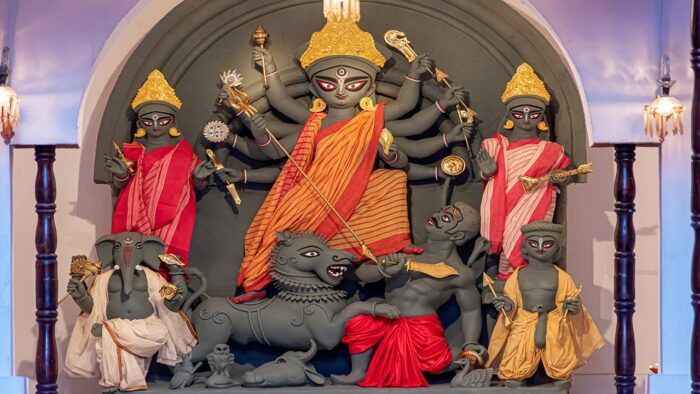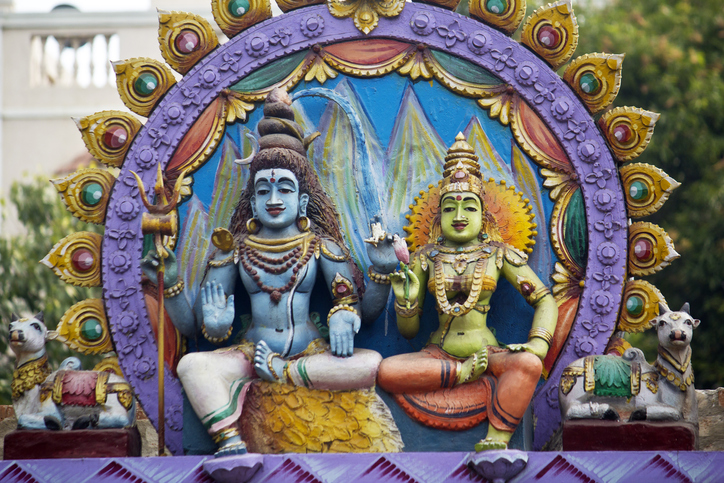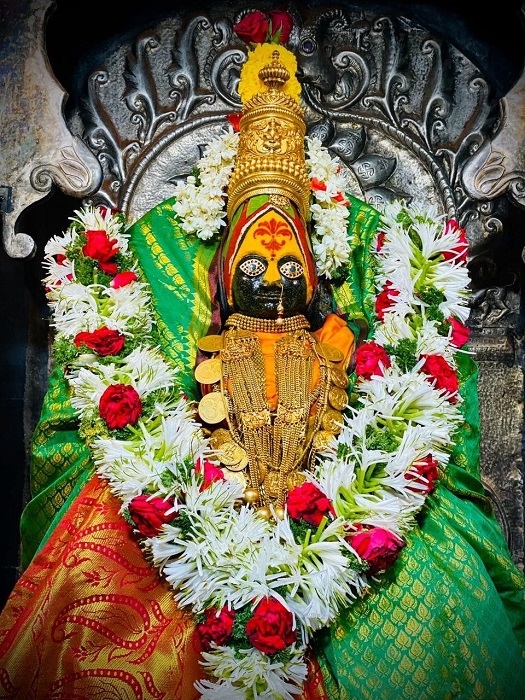Śakti Pīṭhas as the name suggests signifies seats or centers of energy and they are naturally pilgrimage destinations. Śāktam is the specialised worship of goddesses in Sanātana dharma where Śākti is considered to be an embodiment of the divine feminine energy that manifests through female creativity and fertility. She is Shiva’s consort and is worshipped in her nine divine forms during Navaratri.
(Figure 1: Credit: Istock – Shiva Parvati)
A unique feature of Sanatana Dharma is that a majority of its books carry direct or indirect references to mystic experiences. The crème de la crème of Hindu literature has laid out detailed guidelines for self actualisation and finding Divine bliss in one’s own bosom, so that life with proper orientation towards the Divine becomes in fact ‘Life Divine’! Many Sādhaka have had sublime or esoteric experiences while visiting the Śakti Pīṭhas. Bhārat which is also described as Karmabhūmi, has always been the go-to destination for self-seekers because of its history of producing such Sādhakas in huge numbers and the special centers where metaphysical experiences copiously happen.
The Hindu philosophy which is based on ancient science perceives matter as Lord Śiva and energy as Goddess Śakti. As per Purāṇas during the cosmic dance of Śiva and Satī (Śakti) the all-pervasive Vishṇu releases His Cakra and Goddess Satī’s body parts and ornaments fall at various places in the Indian subcontinent. These sacred spots are the 51 Śakti Pīthas, with each one having different subtle energies and also linked to the 51 letters of the Sanskrit alphabet. In early Hinduism, the nature worshipping traditions show the Devi as the goddess of forests, mountains, rivers, and lakes. Hence these Śakti Pīthas are situated on hill tops, caves and by water bodies where mysteries of nature represent the divine. Possibly these are ancient sites of comets, meteors or volcanoes and they have the energy of Ma Satī and Lord Śiva. Every sādhaka who visits these sacred sites and meditates there feels a sacred energy, a change in thought process, and a divine presence in their own selves. These centers allow us to connect with the sacred feminine energy of Icchā, Jnāna, and Kriyā which are desired for spiritual awakening, wisdom, and divinely inspired action in the world.
(Figure 2: Credit: Bhaktiphotos.com –Amba Mata)
Lord Kr̥shṇa himself advises his disciple Arjuna in verse 2.72 of the Bhagavadgītā about the realised person who moves about in society but always centred in the divine realisation:
एषा ब्राह्मी स्थिति: पार्थ नैनां प्राप्य विमुह्यति |
स्थित्वास्यामन्तकालेऽपि ब्रह्मनिर्वाणमृच्छति ||
eṣhā brāmhī sthiti: pārtha naināṁ prāpya vimuhyati
sthitvāsyāmanta-kāle’pi bramha-nirvāṇamr̥cchhati
‘Oh son of Pr̥thā, if one attains such a mystic state, one never gets deluded again; being established in this state even at the hour of death, oneness with supreme state of Bramhan is achieved’.
The great Ādiśankara who achieved unparalleled spitutual heights in his short 32 year sojourn propelled by his mystic connect with Goddess Kāmākshī, writes as follows in verse 22 of the Soundarya-laharī or ‘Beauty of the wave’,
भवानि त्वं दासे मयि वितर दृष्टिं सकरुणां
इति स्तोतुं वाञ्छन् कथयति भवानि त्वमिति यः ।
तदैव त्वं तस्मै दिशसि निजसायुज्य-पदवीं
मुकुन्द-ब्रम्हेन्द्र-स्फुट-मकुट-नीराजितपदाम्
bhavāni tvam dāse mayi vitara dr̥shṭim sakaruṇām
iti stotum vānchan kathayati bhavāni tvam iti ya:
tadaiva tvam tasmai diśasi nija-sāyujya-padavīm
mukunda-bramhendra-sphuṭa-makuṭa-nirājitapadām
The conventional meaning is, “O you Goddess, bestow a kind look on this servant of yours. But no sooner than he commences with the words, ‘O Goddess, you..’,You grant him that state of identity with you, like what Vishnu, Brahma and Indra accomplished by the waving of the bright lights on their crowns.
The above verse brings out the process as well as description of the sādhaka’s mystic state with his Goddess. Interestingly, the word ‘bhavāni’ has the typical आज्ञार्थलोट्लकार Sanskrit declension which is an order to one’s own self ‘to become’; the sādhaka having tasted the divine experience orders himself to become nothing but the Divine Herself. The poem gets a new style of narration and is more emphatic in conveying the same meaning.
(Figure 3: Credit: Pinterest –Tuljabhavani Mata)
A sort of an osmosis takes place between the sādhaka and the deity. He/she starts by asking for a smile or kind look for which the divine mother grants the same status and quality as Herself. The self realised sādhaka waves camphor or whatever light to propitiate the deity which reciprocates in a similar fashion. The Gods like Vishṇu, Bramha, and Indra who are superior to humans by role get the reflection of Her brilliance on their crowns. But the devoted sādhaka is not only given the same treatment but also is shown to be of a higher caliber and made to realise that ‘may he/she become the supreme cosmic force Herself’. Ādiśankara is at His poetic best in describing the beauty and privilege of the sādhaka – the subject becoming the object as per the mahāvākyas of sanātana dharma.
Further in the Nirvāṇa shaṭkam, Ādiśankara writes as,
अहं निर्विकल्पो निराकाररूपो विभुर्व्याप्य सर्वत्र सर्वेन्द्रियाणाम् ।
सदा मे समत्वं न मुक्तिर्न बन्धश्चिदानन्दरूपः शिवोऽहं शिवोऽहम् ॥
aham nirvikalpo nirākārarūpo vibhurvyāpya sarvatra sarvendriyāṇām
sadā me samatvam na muktirna bandha: cidānandarūpa: śivo’ham śivo’ham
‘I am the changeless, formless, substratum, enveloping all, the omnipresent force which operates the senses; I am always in equanimity, beyond freedom as well as bondage; I am the embodiment of knowledge and bliss; I am Śiva the auspiciousness, I am Śiva the auspiciousness’. Auspiciousness as well as the primordial force that created this Universe is neither He nor She nor It.
A devotee can seek a doctor in the deity for medicine for worldly problems, or a banker for additional pleasures and boons, or a teacher for higher knowledge, or the divine itself and love Her for the sake of oneness with the divine only. In the last case, the devotee becomes a Jnānī or realised one.
In shloka no. 3 of the Dakshiṇāmūrti ashṭakam, Shrī Ādiśankara writes,
यस्यैव स्फुरणं सदात्मकमसत्कल्पार्थकं भासतेसाक्षात्तत्त्वमसीति वेदवचसा यो बोधयत्याश्रितान् ।
यत्साक्षात्करणाद्भवेन्न पुनरावृत्तिर्भवाम्भोनिधौतस्मै श्रीगुरुमूर्तये नम इदं श्रीदक्षिणामूर्तये ॥
He, by whose light the dependant universe appears real, teaches the truth of brahman through the vedic mahāvākya ‘tattvamasi’ (that thou art) to those who surrender and on realisation they will not return to the ocean of samsara – to that Dakshiṇāmūrti embodied in the auspicious Guru, I offer my profound salutations.
This Chaitra Navaratri may all the sincere seekers utilise these centers of energy and get the highest blessings according to whatever they seek.
Disclaimer: The opinions expressed in this article belong to the author. Indic Today is neither responsible nor liable for the accuracy, completeness, suitability, or validity of any information in the article.











